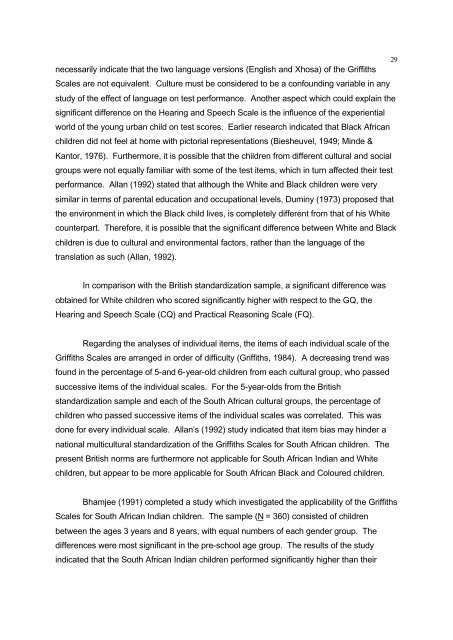nicole kotras masters thesis
nicole kotras masters thesis
nicole kotras masters thesis
You also want an ePaper? Increase the reach of your titles
YUMPU automatically turns print PDFs into web optimized ePapers that Google loves.
necessarily indicate that the two language versions (English and Xhosa) of the Griffiths<br />
Scales are not equivalent. Culture must be considered to be a confounding variable in any<br />
study of the effect of language on test performance. Another aspect which could explain the<br />
significant difference on the Hearing and Speech Scale is the influence of the experiential<br />
world of the young urban child on test scores. Earlier research indicated that Black African<br />
children did not feel at home with pictorial representations (Biesheuvel, 1949; Minde &<br />
Kantor, 1976). Furthermore, it is possible that the children from different cultural and social<br />
groups were not equally familiar with some of the test items, which in turn affected their test<br />
performance. Allan (1992) stated that although the White and Black children were very<br />
similar in terms of parental education and occupational levels, Duminy (1973) proposed that<br />
the environment in which the Black child lives, is completely different from that of his White<br />
counterpart. Therefore, it is possible that the significant difference between White and Black<br />
children is due to cultural and environmental factors, rather than the language of the<br />
translation as such (Allan, 1992).<br />
In comparison with the British standardization sample, a significant difference was<br />
obtained for White children who scored significantly higher with respect to the GQ, the<br />
Hearing and Speech Scale (CQ) and Practical Reasoning Scale (FQ).<br />
Regarding the analyses of individual items, the items of each individual scale of the<br />
Griffiths Scales are arranged in order of difficulty (Griffiths, 1984). A decreasing trend was<br />
found in the percentage of 5-and 6-year-old children from each cultural group, who passed<br />
successive items of the individual scales. For the 5-year-olds from the British<br />
standardization sample and each of the South African cultural groups, the percentage of<br />
children who passed successive items of the individual scales was correlated. This was<br />
done for every individual scale. Allan’s (1992) study indicated that item bias may hinder a<br />
national multicultural standardization of the Griffiths Scales for South African children. The<br />
present British norms are furthermore not applicable for South African Indian and White<br />
children, but appear to be more applicable for South African Black and Coloured children.<br />
Bhamjee (1991) completed a study which investigated the applicability of the Griffiths<br />
Scales for South African Indian children. The sample (N = 360) consisted of children<br />
between the ages 3 years and 8 years, with equal numbers of each gender group. The<br />
differences were most significant in the pre-school age group. The results of the study<br />
indicated that the South African Indian children performed significantly higher than their<br />
29
















